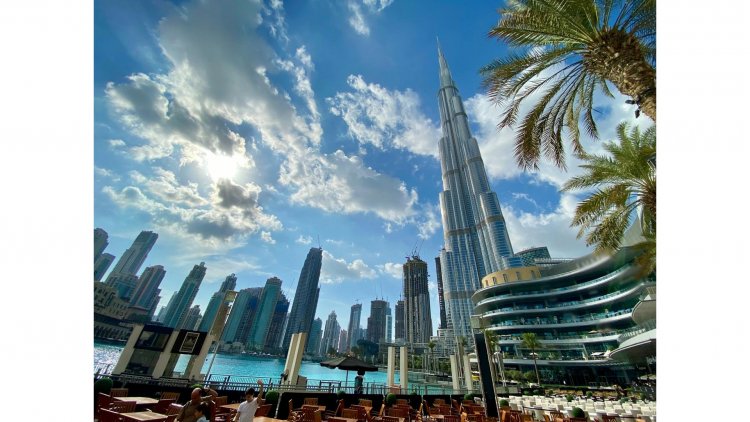Dubai's Architectural Wonderland: A Journey Through Modern Marvels
Dubai, a city where the future seems to unfold before our eyes, stands as a testament to the boundless possibilities of modern architecture. This desert metropolis, once a humble trading post, now dazzles with its architectural audacity and innovative designs. From the world’s tallest buildings to groundbreaking eco-friendly projects, Dubai is not merely a place but a canvas where architects and visionaries push the limits of design and engineering. Let’s dive into the architectural wonders of this dynamic city and explore what makes Dubai a beacon of modernity.

The Pinnacle of Innovation: Burj Khalifa
At the heart of Dubai’s skyline, the Burj Khalifa reigns supreme as the tallest man-made structure in the world. Standing at a staggering 828 meters (2,717 feet), this architectural marvel is more than just a skyscraper—it’s a symbol of Dubai's unyielding ambition.
Designed by the renowned architectural firm, Adrian Smith + Gordon Gill Architecture, the Burj Khalifa features a sleek, tapered spire that rises gracefully above the city. The building's design is inspired by the Hymenocallis flower, a desert bloom known for its long, delicate petals. This botanical inspiration is evident in the structure’s tiered, spiraling form which not only enhances its aesthetic appeal but also contributes to its stability.
Inside, the Burj Khalifa houses a luxury hotel, residential apartments, and corporate suites. The interiors, designed by ** Giorgio Armani**, reflect a sophisticated blend of modernity and elegance. The observation decks on the 148th and 124th floors offer breathtaking panoramic views of Dubai and beyond, cementing the Burj Khalifa’s status as a must-visit landmark.
But the Burj Khalifa is not merely a towering achievement in design; it represents a leap in engineering prowess. The building’s core is reinforced with high-strength concrete and supported by a series of buttressed cores, allowing it to withstand extreme weather conditions and seismic activities. This feat of engineering demonstrates Dubai’s commitment to pushing the envelope in construction technology.
The Pinnacle of Sustainability: The Dubai Sustainable City
As the world becomes increasingly aware of environmental issues, Dubai is also making strides in sustainable architecture. One of the city's most notable projects in this arena is The Dubai Sustainable City. This pioneering development embodies the principles of eco-friendly living, aiming to set new standards for sustainable urban environments.
Launched in 2015, The Dubai Sustainable City is designed to be a zero-energy community. It integrates advanced technologies and sustainable practices to minimize its carbon footprint. The city features solar panels on every rooftop, a system for recycling water and waste, and extensive green spaces that promote biodiversity.
The architectural design of The Dubai Sustainable City reflects its commitment to sustainability. The buildings are constructed with energy-efficient materials and feature passive cooling systems to reduce reliance on air conditioning. Additionally, the development emphasizes the use of natural light and ventilation, reducing the need for artificial lighting and mechanical cooling.
The Dubai Sustainable City also includes innovative green technologies such as electric vehicle charging stations and smart irrigation systems for its gardens and parks. This holistic approach to sustainable living aims to create a community that is both environmentally responsible and comfortable for its residents.
The Marquee of Modernity: Dubai Marina
Dubai Marina, an artificial canal city built along a two-mile stretch of Persian Gulf shoreline, epitomizes modern luxury and urban sophistication. This vibrant district is renowned for its stunning skyscrapers and high-end lifestyle, offering a glimpse into the future of urban development.
The architecture of Dubai Marina is characterized by its eclectic mix of styles and shapes, each building contributing to a dynamic and ever-changing skyline. Notable among these is the Cayan Tower, also known as the “Twisting Tower.” Designed by Skidmore, Owings & Merrill, the Cayan Tower is a 75-story skyscraper that twists 90 degrees from base to top, creating a striking visual effect. This twisting design not only enhances the building's aesthetic appeal but also optimizes views for its occupants.
Another standout in Dubai Marina is the Jumeirah Beach Residence (JBR), a development that combines residential, commercial, and recreational spaces. The architecture of JBR features sleek, modern lines and extensive use of glass, creating a bright and open atmosphere. The development’s waterfront location provides residents with stunning views of the marina and the Arabian Gulf.
Dubai Marina is also home to the Marina Walk, a bustling promenade lined with upscale restaurants, shops, and cafes. This vibrant area serves as a social hub, bringing together the community and enhancing the urban experience. The Marina Walk is surrounded by some of Dubai’s most iconic skyscrapers, making it a popular destination for both residents and tourists.
The Iconic Vision: Palm Jumeirah
One of the most ambitious engineering feats in Dubai is the creation of Palm Jumeirah, an artificial archipelago designed to resemble a palm tree when viewed from above. This sprawling development is a testament to Dubai’s ability to turn visionary concepts into reality.
Palm Jumeirah is home to numerous luxury hotels, including the world-famous Atlantis, The Palm. Designed by Wimberly, Allison, Tong & Goo, Atlantis is a striking example of opulent architecture, featuring a unique blend of Arabian and contemporary design elements. The resort’s distinctive “Royal Towers” are connected by a stunning archway and are surrounded by lush gardens and water features, creating an oasis of luxury.
The Palm Jumeirah’s residential areas are equally impressive, featuring an array of high-end villas and apartments. The architecture of these properties often incorporates traditional Arabian motifs, creating a harmonious blend of modern luxury and cultural heritage.
The infrastructure of Palm Jumeirah is also noteworthy. The island is connected to the mainland by a bridge and a monorail system, ensuring easy access for residents and visitors. The Palm Jumeirah’s design incorporates state-of-the-art amenities, including a network of canals and marinas, further enhancing its appeal as a premier destination for luxury living.
The Futuristic Flair: Dubai Opera
Adding a touch of cultural elegance to Dubai’s architectural landscape is the Dubai Opera, a multi-format performing arts center located in Downtown Dubai. Designed by Atkins, the Dubai Opera’s architectural design is inspired by the traditional Arabian dhow boats, with its curved roof and sweeping lines evoking the sails of these historic vessels.
The Dubai Opera is a versatile venue capable of hosting a wide range of events, from opera and ballet to concerts and theatrical performances. Its interior features a state-of-the-art stage and seating arrangement that can be reconfigured to accommodate different types of performances.
The building’s exterior is equally impressive, with its glass facade reflecting the changing colors of the sky and the surrounding skyline. The Dubai Opera is situated in a prime location, overlooking the Burj Khalifa and the Dubai Fountain, making it a focal point of the city’s cultural and entertainment scene.
The surrounding area, known as Opera District, complements the Dubai Opera with its blend of residential, commercial, and leisure spaces. This district aims to create a vibrant urban environment that fosters creativity and cultural exchange.
The Architectural Evolution: Alserkal Avenue and the Creative Hub
Moving beyond the grandeur of skyscrapers and luxury developments, Dubai’s architectural landscape also includes innovative spaces dedicated to culture and creativity. Alserkal Avenue is a prime example of this evolution. Located in the Alserkal district, this contemporary art and design hub has transformed an industrial area into a vibrant cultural precinct.
Alserkal Avenue is home to a diverse range of art galleries, design studios, and creative spaces, each housed in repurposed warehouse buildings. This adaptive reuse of industrial structures not only preserves the area’s historical character but also fosters a dynamic environment for artistic expression. The architecture of Alserkal Avenue reflects a minimalist aesthetic, with clean lines and open spaces that provide a blank canvas for creative endeavors.
One of the standout spaces within Alserkal Avenue is the Leila Heller Gallery, known for its striking modern design and innovative exhibitions. Another significant addition is the Concrete, an architecture and design space that showcases cutting-edge projects and hosts events focused on contemporary design trends.
Alserkal Avenue’s architectural design emphasizes flexibility and functionality, allowing for a constantly evolving cultural scene. The area’s transformation is a testament to Dubai’s commitment to nurturing creativity and fostering a thriving arts community.
The Green Frontier: The One Za'abeel and The Link
Dubai’s commitment to sustainability and innovation is also reflected in the ambitious designs of projects like One Za'abeel and The Link. These developments represent the city’s drive to integrate cutting-edge technology with eco-friendly principles.
One Za'abeel is a supertall skyscraper that, upon completion, will hold the title of the world’s tallest building by height to the top of its spire. Designed by Adrian Smith + Gordon Gill Architecture, One Za'abeel features a unique design with a twist—literally. The building’s form is a series of stacked, rotated cubes, which not only creates a visually striking effect but also enhances structural stability.
In addition to its impressive height, One Za'abeel incorporates sustainable design elements such as energy-efficient glass and advanced cooling systems. The tower is also set to include a high-tech observatory with panoramic views, adding to its allure as a landmark of modern architecture.
The Link, another significant project, is a futuristic development focused on creating a seamless connection between various parts of the city. Designed with an emphasis on mobility and accessibility, The Link will feature a network of elevated walkways and transportation hubs that integrate with existing infrastructure. The project’s architectural design includes sleek, flowing lines and transparent materials, emphasizing openness and connectivity.
These projects illustrate Dubai’s forward-thinking approach to architecture, where technological innovation and environmental consciousness go hand in hand.
The Cultural Cornerstone: Museum of the Future
As a city that constantly looks to the future, Dubai’s Museum of the Future stands as a beacon of innovation and imagination. Opened in 2022, this striking building is more than just a museum—it’s a symbol of Dubai’s vision for the future of humanity.
Designed by Killa Design, the Museum of the Future features a distinctive torus shape with a hollow center, symbolizing an open horizon and endless possibilities. The building’s facade is covered with intricate Arabic calligraphy, which is not only a nod to Dubai’s cultural heritage but also serves as a dynamic, illuminated surface that changes with the light.
The museum’s interior is designed to immerse visitors in futuristic concepts and technologies. Exhibits cover a range of topics, from space exploration to advanced robotics, offering a glimpse into what the future might hold. The architectural design of the museum complements its exhibits, creating a space that feels both cutting-edge and reflective of Dubai’s commitment to innovation.
The Museum of the Future is situated in the heart of the city, adjacent to the Burj Khalifa and other key landmarks. Its design and purpose reinforce Dubai’s role as a global leader in technology and forward-thinking solutions.
The Zen Zone: The Green Planet and City Walk
Amidst Dubai’s towering skyscrapers and bustling urban environment, The Green Planet offers a refreshing escape into nature. Located within the City Walk development, The Green Planet is an indoor tropical rainforest that showcases Dubai’s commitment to sustainability and environmental education.
Designed by buro Happold, The Green Planet features a geodesic dome structure that houses a diverse range of flora and fauna. The architectural design of the dome allows for the creation of a controlled environment where visitors can experience the beauty and complexity of a rainforest ecosystem.
The Green Planet’s design incorporates energy-efficient systems and sustainable practices, such as rainwater harvesting and the use of natural light. The space also includes educational exhibits and interactive displays that promote awareness about conservation and biodiversity.
Adjacent to The Green Planet, City Walk is a mixed-use development that blends modern urban design with green spaces. The architectural design of City Walk features a combination of contemporary buildings and landscaped areas, creating a balanced environment that encourages both relaxation and activity. The development includes shopping, dining, and entertainment options, making it a popular destination for residents and tourists alike.
The Gateway to Tradition: Al Fahidi Historical Neighborhood
While Dubai is renowned for its modern architecture, the Al Fahidi Historical Neighborhood offers a glimpse into the city’s past. This well-preserved area provides a stark contrast to the contemporary skyline, showcasing traditional Emirati architecture and urban design.
The Al Fahidi Historical Neighborhood, also known as Al Bastakiya, features narrow winding streets and traditional wind-tower buildings known as barjeel. These structures were designed to provide natural ventilation and cooling, a testament to the ingenuity of traditional Emirati architecture.
The neighborhood is home to several cultural landmarks, including the Dubai Museum and the Sheikh Mohammed Centre for Cultural Understanding. These institutions offer insights into Dubai’s history, heritage, and cultural practices, enriching visitors’ understanding of the city’s evolution.
The preservation of Al Fahidi Historical Neighborhood is a testament to Dubai’s efforts to honor its past while embracing the future. The area serves as a cultural and educational hub, bridging the gap between tradition and modernity.
Dubai’s architectural landscape is a tapestry of innovation, sustainability, and cultural heritage. Each project, from the towering Burj Khalifa to the sustainable Dubai Sustainable City, contributes to the city’s dynamic and evolving identity. Whether you’re marveling at the sleek lines of contemporary skyscrapers or exploring the historical streets of Al Fahidi, Dubai’s architecture offers a compelling narrative of a city that is continuously shaping its future while honoring its past.
Disclaimer: The travel information and recommendations on this blog are intended for general guidance and inspiration. Conditions and regulations can change quickly, so please verify all details with appropriate sources before making travel plans. We are not liable for any errors, omissions, or outcomes resulting from your use of this information. Travel involves inherent risks, and it's essential to prioritize your safety and well-being. Always travel with adequate insurance and take necessary precautions.
What's Your Reaction?





















